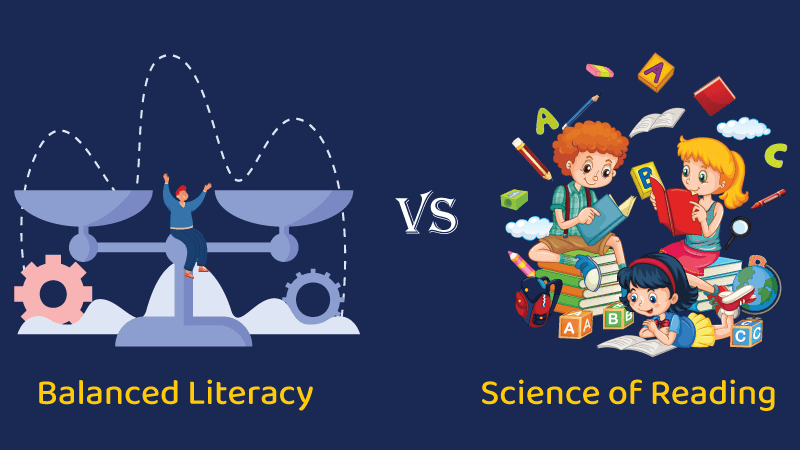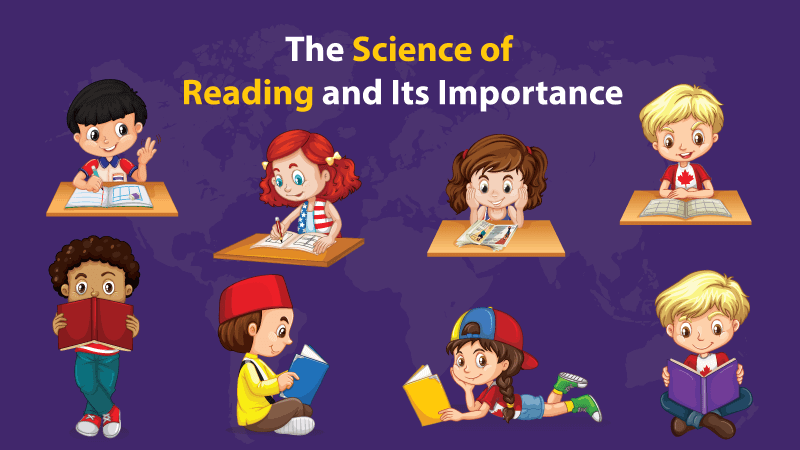
In education, the battle between different teaching methodologies often takes center stage. One such debate is the comparison between Balanced Literacy and the Science of Reading.
Both approaches are pivotal in shaping how individuals learn to read and comprehend written language. Let's analyze and explore these methods to understand their strengths, weaknesses, and educational implications.
What is Balanced Literacy?
Balanced Literacy is an educational approach designed to foster comprehensive reading and language development in students. This methodology seeks to balance various components of literacy instruction, aiming to create well-rounded and proficient readers.
What is Science of Reading?
The Science of Reading is an evidence-based approach to teaching reading that draws on cognitive science, linguistics, and neuroscience to understand how the human brain learns to read.
Understanding the Balanced Literacy
Balanced Literacy is an approach that integrates various strategies and techniques to foster holistic reading development. This method encompasses a blend of teacher-guided instruction and student-centered activities to create a comprehensive learning experience.
Within this Literacy framework, students engage in reading, writing, listening, and speaking activities. This approach emphasizes the importance of creating a literate environment and encourages students to explore various reading materials, including storybooks, newspapers, and digital content.
Educators incorporate several critical elements in a Balanced Literacy framework to ensure a holistic approach to reading instruction. These elements typically include:
- Phonics and Decoding: Providing students with explicit instruction on phonics rules and decoding strategies to help them decipher and read words accurately.
- Vocabulary Development: Enhancing students' vocabulary by exposing them to a wide range of words and helping them understand word meanings in context.
- Fluency Practice: Encouraging students to read fluently and expressively to improve their reading speed, accuracy, and comprehension.
- Comprehension Strategies: Teaching students various strategies to understand, analyze, and critically engage with different types of texts.
- Writing Skills: Integrating writing activities that enable students to apply their reading skills in composing coherent and meaningful texts.
- Listening and Speaking Skills: Promoting active listening and effective communication through discussions, presentations, and peer interactions.
Understanding the Science of Reading
On the other hand, The Science of Reading is a methodology rooted in cognitive science and linguistics. This approach strongly emphasizes decoding, phonics, and understanding the mechanics of language. Proponents of this approach argue that a solid foundation in phonics and decoding skills is essential for proficient reading.
At the core of the Science of Reading are several fundamental principles:
- Phonemic Awareness: This refers to recognizing and manipulating individual sounds, or phonemes, in spoken language. Developing phonemic awareness helps lay the foundation for understanding the relationship between sounds and letters.
- Phonics Instruction: This Reading strongly emphasizes teaching phonics—the correspondence between letters and their associated sounds. By systematically teaching phonics rules, students learn how to decode words accurately.
- Decoding Strategies: Students are taught explicit strategies to break down words into their phonemes and blend them to read unfamiliar words. This empowers students to decode words independently.
- Structured Vocabulary Development: The approach promotes the introduction of new words in a structured manner, helping students build a strong foundation of vocabulary and word meanings.
- Reading Comprehension: While emphasizing phonics and decoding, the Science of Reading also recognizes the importance of comprehension. It encourages teaching students how to comprehend and analyze texts effectively.
Strengths of the Science of Reading
The Science of Reading prioritizes foundational skills and has shown success in improving reading outcomes. Critics, though, worry that it might oversimplify the reading process.
- Evidence-Based Approach: This technichs is founded on rigorous research and cognitive science principles. Its evidence-based nature provides educators with a clear roadmap for effective reading instruction.
- Phonics Emphasis: By focusing on phonics and decoding skills, it equips students with the tools to read unfamiliar words independently, enhancing their reading accuracy.
- Addressing Reading Difficulties: The structured nature of the Science of Reading makes it particularly effective for students with reading difficulties, such as dyslexia. It offers targeted strategies to overcome challenges.
Strengths of the Balanced Literacy
Balanced Literacy promotes a love for reading and considers students' interests. However, critics argue that it might not provide sufficient phonics instruction for struggling readers.
- Holistic Learning: Balanced Literacy integrates various language skills, including reading, writing, speaking, and listening. This approach promotes well-rounded language development.
- Individualized Instruction: This approach allows educators to tailor instruction to individual student needs, accommodating diverse learning styles and paces.
- Promotes a Love for Reading: Encouraging students to explore various materials fosters a genuine passion for reading beyond the classroom.
The Impact on Education
Balanced Literacy's Pedagogical Impact
Proponents of Balanced Literacy praise its holistic approach for fostering a love for reading. It allows students to explore various genres and develop their own reading preferences. However, some argue that the lack of explicit phonics instruction might hinder struggling readers.
The Science of Reading's Educational Implications
Advocates of the Science of Reading argue that a strong phonics foundation is essential for early reading success. By focusing on explicit instruction, students are equipped with the tools needed to decode unfamiliar words. Critics, though, express concerns that an excessive emphasis on mechanics might lead to disengagement.
Impact on Early Reading Skills
- Building Strong Foundations: The Science of Reading asserts that decoding proficiency leads to better reading comprehension. Balanced Literacy argues that exposure to a variety of texts fosters comprehension skills.
- Addressing Reading Difficulties: The Science of Reading offers targeted interventions for struggling readers. Balanced Literacy aims to address difficulties through a multifaceted approach.
Comparison Between Balanced Literacy and Science of Reading
|
Topic |
Balanced Literacy |
Science of Reading |
|
Approach and Methodology |
Balanced Literacy draws from a constructivist approach, encouraging students to actively construct their understanding of texts. It incorporates strategies like guided reading, shared reading, and independent reading to develop various reading skills. |
The Science of Reading aligns more with a behaviorist approach, where reading skills are broken down into explicit components and systematically taught. |
|
Role of Phonics |
Phonics instruction might not be as structured and explicit. It's often integrated into broader language activities. |
It places a high value on systematic phonics instruction, considering it a cornerstone for reading proficiency. |
|
Flexibility vs. Structure |
This methodology offers flexibility in choosing reading materials and approaches, catering to students' interests and diverse learning styles. |
This approach, while adaptable, leans towards a more structured framework, focusing on specific skills and techniques. |
|
Reading Comprehension |
This approach emphasizes comprehension through discussions and activities that encourage critical thinking. |
This, too, emphasizes comprehension, but with a strong emphasis on decoding skills to facilitate understanding. |
|
Teacher's Role in Each Approach |
It encourages teachers to be facilitators of learning, adapting their instruction based on students' needs. |
It often prescribes a structured curriculum, with teachers playing a more directive role in delivering phonics lessons. |
|
Adaptability to Diverse Learners |
This Literacy offers flexibility, allowing educators to tailor instruction to individual students. |
It structured nature can sometimes be challenging for students with diverse learning styles. |
|
Comprehensive Language Skills |
This approach aims to develop overall language skills, including communication and critical thinking. |
This approach focuses on decoding but acknowledges the importance of comprehension. |
|
Fostering a Love for Reading |
Balanced Literacy's diverse reading experiences can ignite a lifelong passion for reading. |
The Science of Reading's focus on decoding proficiency may not inherently inspire the same level of enthusiasm. |
The Balanced Literacy vs. Science of Reading debate continues, with educators, researchers, and policymakers weighing the pros and cons of each approach. Ultimately, the effectiveness of these methods can vary based on individual students and school contexts.
The debate between Balanced Literacy and the Science of Reading underscores the complexity of teaching and learning to read. Both approaches have their merits, and their effectiveness depends on various factors.

